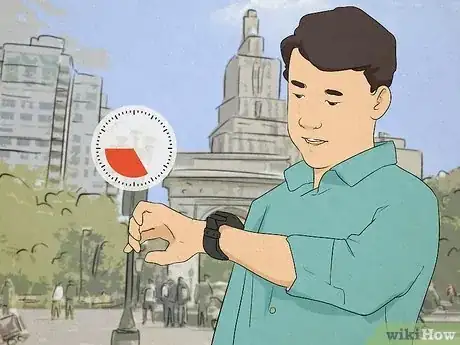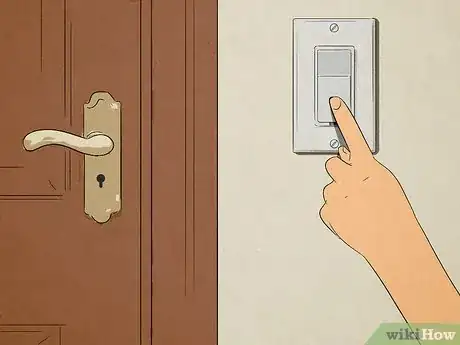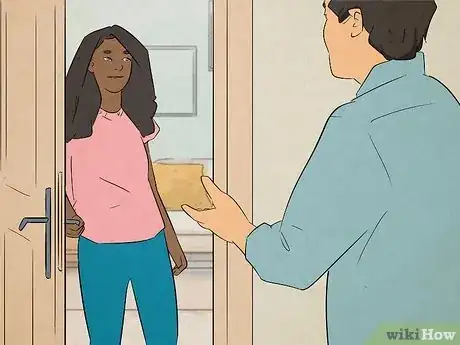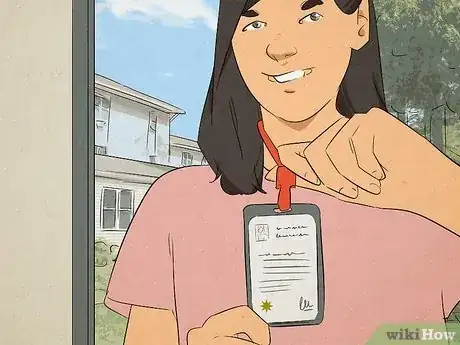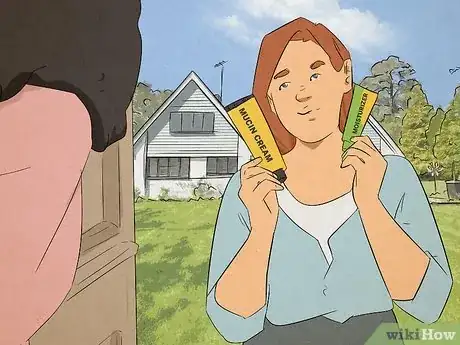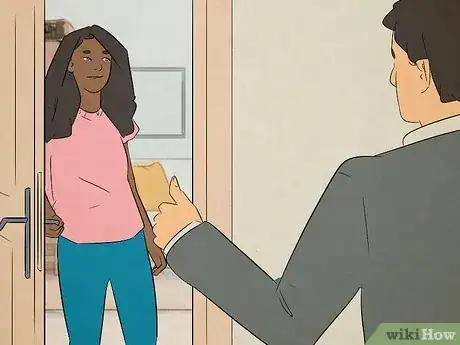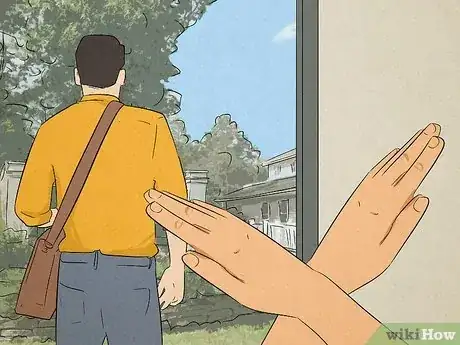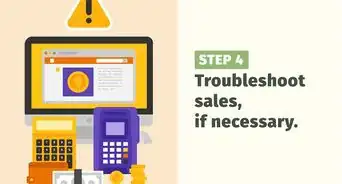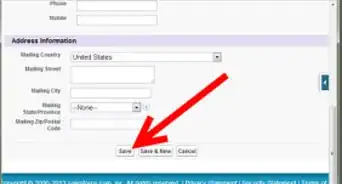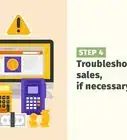wikiHow is a “wiki,” similar to Wikipedia, which means that many of our articles are co-written by multiple authors. To create this article, 41 people, some anonymous, worked to edit and improve it over time.
wikiHow marks an article as reader-approved once it receives enough positive feedback. This article received 12 testimonials and 95% of readers who voted found it helpful, earning it our reader-approved status.
This article has been viewed 311,714 times.
Learn more...
Selling door to door can be a difficult and intimidating way to conduct business. Still, in many instances it is the best way to bring certain products and services to people's attention. If you have the right approach, you can increase your chances of success, and maybe even find some enjoyment in the process.
Steps
Going door to door
-
1Dress appropriately. You need to look presentable to the customers you want to reach. In most cases, wearing a tie looks much better than jeans and a t-shirt. You will be walking around in these clothes, so they do need to be comfortable.
- Don't overdo your clothing. A new, finely tailored suit can be somewhat intimidating, especially if it makes you look incredibly out of place in the neighborhood you are walking through.
-
2Pick the right time to go selling. During the work week, most people are at home and willing to answer their door between the hours of 5:00 and 9:00 pm. You may get people at home during traditional 9:00 am to 5:00 pm work hours, but not as many. Early in the morning is not good, as many people up and about are looking to go to work, not listen to a sales pitch.[1]Advertisement
-
3Knock on the door or ring the doorbell. Step away from the door after knocking. It's less intimidating and respects personal space.
-
4Start with a greeting. Avoid your sales pitch at first. A simple, "Hello, how are you today?" treats each person as an individual rather than just a potential customer. You want the person to trust you and want to talk to you.
- Observe your surroundings when approaching the door and gather hints on the customer's interests to help break the ice.
- Tweak your introduction from time to time to keep things fresh. It can be easy to fall into a rut, and act like you are reading prepared remarks rather than talking to someone.
-
5Be friendly and confident. You aren't just selling a product, you are selling yourself as a trustworthy representative of the company you work for. Potential customers should want to invite you in for more information. It's always better to smile and make eye contact as much as possible.[2]
-
6Be persistent and patient. Most doors you knock on will not want to talk to you. Don't get discouraged by people saying no. You aren't looking for everyone to buy your products, just the people who are interested.
Making the sale
-
1Know your product well. You need to be sure you know everything there is to know about what it is you are trying to display, and answer any and all questions that your potential customers have. This is true whether you selling a company's "top of the line" merchandise, or you just want to get some extra cash for homemade items.
- This will allow you to explain the product on a personal level. You don't want to dive right into the bullet points. Instead, let your customer know how this will benefit their life.
- Be honest about what your product can and cannot do. You won't always have a good answer to a customer's question, but don't make promises your product can't keep. Instead, try to turn the conversation back towards your product's strengths.
-
2Have a quick, precise introduction as to who you are and why you are there. You have a very short window of time to capture a buyer's interest in your product. Keep this introduction casual. You don't want to come off as overly animated. This is an in-person presentation, not a goofy television commercial.
- You can say something like, "I'm (your name), and I'm visiting your neighborhood to inform people about (your product or service). Let me show you what I've got." Get to the point quickly, so you don't waste time talking to a customer who isn't interested.
-
3Establish your authenticity. Sadly, many scams use door to door salesmen to snare victims, and some areas ban and issue fines for some unsolicited sales as a result; so you may want business cards or something tangible to prove that you a verified sales representative for an actual company. If you are working independently, you will want some of your product with you, and be willing to sell right away.
-
4Pay attention your customer. Pick up hints in tone and body language that indicate interest in you or your product. Interested people tend to maintain eye contact, lean forward, or tilt their head when you talk. Give them a chance to talk, ask questions, or offer suggestions about how they might be interested in using your product.[3] If the conversation starts to drag, move on to discussing the product. If the customer is not showing any signs of interest, thank them for their time, and move on to the next door.
- Keep an eye out for negative body language as well. Crossed arms or eyes looking elsewhere indicate the person is not interested, or is trying to keep you at a distance.
-
5Demonstrate the product. If a person seems interested, but not yet willing to buy, offer to show them the product and how it works. If the person at the door expresses interest, say, "let me show you," rather than, "can I" or "may I." Those phrases open a window for the person to say no. It also looks pushy, like you are trying to force your way into someone else's house.
- Trust your product to work. Don't offer excuses before you show what it does or can do. You need to demonstrate that what you are selling is quality and worthwhile.
- Showing your product also gives the customer a chance to think about how it might be useful to them. Encourage them to describe their needs, and answer any questions.
Convincing a Hesitant Buyer
-
1Learn the common negative responses. Chances are that after going to a bunch of houses, you will hear certain similarities in disinterest. Keep an eye out for these basic themes, and prepare answers. You may not always get past them, but you will be prepared to address some early concerns.[4]
- A negative buyer can still be open to persuasion. Don't see those negative responses as refusals, but as opportunities to give more information.
-
2Focus on your product's benefits. Your potential customer needs to know that what you are selling will give them something they want. You should know the difference between a "benefit" and a "feature." A feature is something your product does, such as a vacuum that picks up more dirt than its competitors. A benefit is what you get from that feature. For that vacuum, the benefit would be a cleaner, healthier home.[5]
-
3Be positive about your product. If your potential customer seems unwilling to buy, let your enthusiasm guide them. If they can't believe that you like or believe in your product, why should they?
-
4Offer to provide more information. Most people will not want to stand in their doorway for too long, so if there is an opportunity to talk further, they will generally invite you inside. If possible, try to get contact information. With that, you can always offer to come back or call at another time.
- If you have fliers, business cards, or other printed materials with your contact information, this is a good moment to pass them out. If you don't have any, it might be good to get some.
-
5Pay attention to clear rejections. If a person gives you a direct "No" in response to your offers, thank them for their time and move on to the next house. There is no benefit to pushing that person any further.
Community Q&A
-
QuestionHow can I get a sale at every home?
 Community AnswerYou can't. Most door to door salesmen see 30+ people a day, but there is only an average of 2 sales a day. Don't be disheartened; it is virtually impossible to have a product that everyone wants. On the flip side, direct marketing is more likely to cause a long term customer.
Community AnswerYou can't. Most door to door salesmen see 30+ people a day, but there is only an average of 2 sales a day. Don't be disheartened; it is virtually impossible to have a product that everyone wants. On the flip side, direct marketing is more likely to cause a long term customer. -
QuestionWhat are some examples of door to door introductions?
 Community Answer"Hi, how are you?" Wait for response and reply appropriately "My name is ____, I'm in the area today because there's been a high demand in the community for ____ . We did a leaflet drop about a month ago, did you happen to see it? ... No? Haha probably fired in the bin eh?!" (Get them smiling) "That's no problem, that's why I'm here. My job today is to let all the homeowners in the community know how our product works. (Very brief and vague description) Are all the decision makers home at the minute?" Yes - "Perfect, it only takes a few minutes to run through so I can pop in and explain it to you" No - "No problem I'll be in the area until about 9pm, what time would be best?". Get their contact details and call back when they say it'd be fine. Also learn to leave well alone those who wish to be left alone.
Community Answer"Hi, how are you?" Wait for response and reply appropriately "My name is ____, I'm in the area today because there's been a high demand in the community for ____ . We did a leaflet drop about a month ago, did you happen to see it? ... No? Haha probably fired in the bin eh?!" (Get them smiling) "That's no problem, that's why I'm here. My job today is to let all the homeowners in the community know how our product works. (Very brief and vague description) Are all the decision makers home at the minute?" Yes - "Perfect, it only takes a few minutes to run through so I can pop in and explain it to you" No - "No problem I'll be in the area until about 9pm, what time would be best?". Get their contact details and call back when they say it'd be fine. Also learn to leave well alone those who wish to be left alone. -
QuestionWhat are good warm ups? What is best to say when the home owner answers the door?Practice in front of family or friends, or in front of a mirror. Concentrate on using appropriate body language and being friendly.
Warnings
- Complimenting on the appearance of the opposite sex is inappropriate.⧼thumbs_response⧽
- Always use the sidewalks while roaming about. If there are none, walk as far off the street as possible.⧼thumbs_response⧽
- Do not enter fenced in houses. Animals hate soliciting more than people do.⧼thumbs_response⧽
References
- ↑ http://consumerist.com/2010/05/26/i-spent-two-days-as-a-door-to-door-salesman/
- ↑ https://www.shopify.com/guides/make-your-first-ecommerce-sale/door-to-door
- ↑ http://sales-techniques.net/lesson4-product-presentation/
- ↑ http://sales-techniques.net/lesson-3-what-to-say-and-do-at-the-door/
- ↑ http://www.inc.com/geoffrey-james/6-ways-to-convince-customers-to-buy.html
About This Article
Selling anything door to door can be difficult and intimidating, but by taking a confident approach you'll stand a better chance of being successful. You’ll need to dress smartly and look presentable, so try wearing a shirt with a skirt or dress pants. Aim to go selling between 5:00 and 9:00 pm, as this is when most people will be home from work. When you knock on each door, have a quick introduction ready about who you are and the product you’re selling. Be friendly and confident as you talk to the person, as this will help you build rapport. If the person seems interested, you can offer to demonstrate the product to them. For more tips on selling anything door to door, like how to convince a hesitant buyer, read on!

